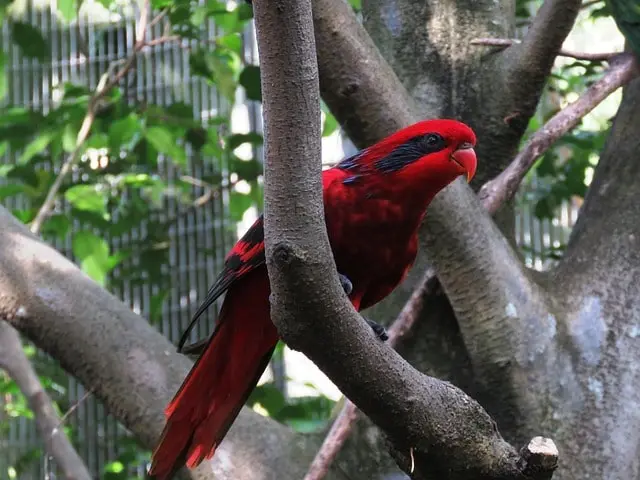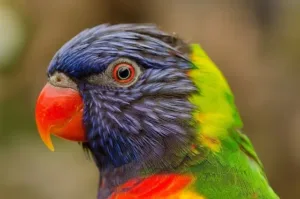Parrots come in almost every color you can think of, making them one of the most colorful creatures on the planet. Most parrots usually feature a combination of two or three colors, while some are bathed in the hues of the rainbow.
The bright and beautiful colors of parrots have made them the most coveted pet bird species in the world. They are also admired by bird watchers across the globe for their ethereal plumage. In this feature, we will talk about the most colorful parrot species that are a sight to behold.
Quick Navigation
Colorful Parrot Species
Here are the most colorful and beautiful parrot species in the world:
Rainbow Lorikeet
The rainbow lorikeet is aptly named for the spectrum of colors they bring. When flying in groups, these birds look like small rainbows in the sky.
The rainbow lorikeet has a uniquely stunning look with a vivid array of colors on its body. Its head and lower belly are colored blue, while the breast is yellow and orange. A yellow collar accentuates the nape, and the wings, tail, and back are green.
Rainbow Lorikeets are nectar feeders and have specialized brush-tipped tongues for extracting nectar from flowers. In addition to nectar, they also consume fruits, pollen, and seeds.
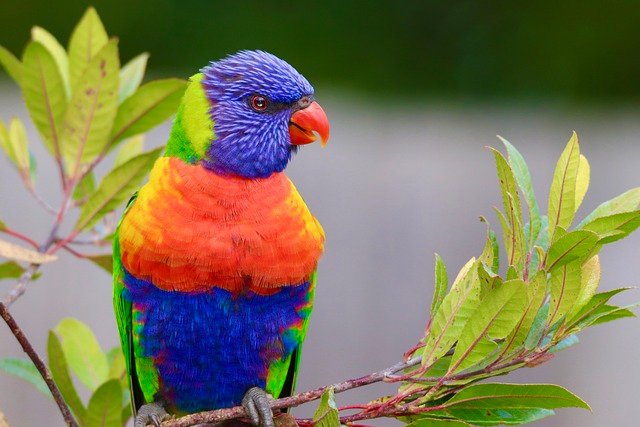
Eclectus Parrots
Eclectus Parrots are a sexually dimorphic species, meaning the males and females of the same can be sexed based on their physical appearance. The sexual dimorphism between the genders of eclectus parrots is so extreme that aviculturists initially thought they were two different species.
Males feature a vibrant emerald green plumage with bright orange beaks and some blue and red under the wings. Females have predominantly red with deep purple markings on their chests and tails and a black beak.
Eclectus parrots are often described as calm and docile pets. They have different care requirements from other parrots. Eclectus parrots are frugivores and mainly eat fruits, nectar, and plants.

Galah Cockatoo
The galah cockatoo is an Australian native and one of the few pink parrots. It has a pink face, chest, abdomen, and a whitish-pink crest. The back and the wings are grey.
The rose-breasted cockatoo is just as intelligent as it is alluring. It is fond of human interaction and loves to learn. This pink species of cockatoo can learn a bunch of words, phrases, and sounds and has an impeccable speaking ability.
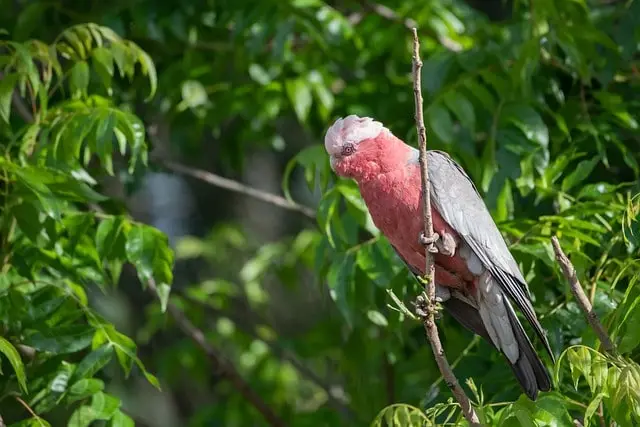
Major Mitchell’s Cockatoo
The Major Mitchell’s cockatoo sports a smooth coat of white and pink feathers over its body. It has a beautifully colored crest that appears normal when folded but showcases a combination of yellow and red bands when raised.
Major Mitchell’s cockatoos are admired by everyone, including parrot enthusiasts. They are considered to be great pet parrots having a friendly and gentle disposition. They are smart and active birds but can act a bit aloof and moody at times.
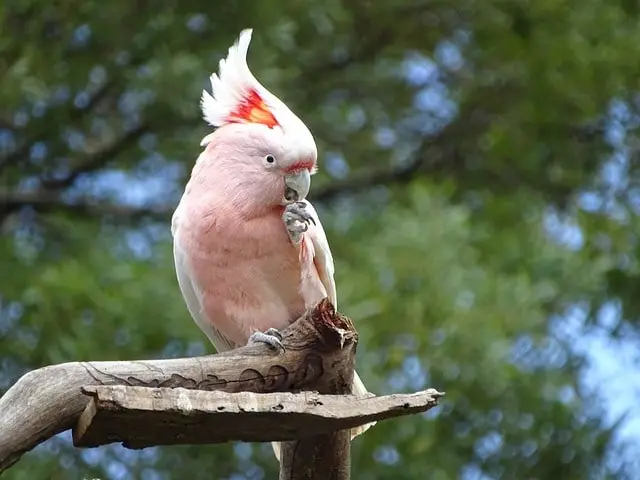
Hyacinth Macaw
The Hyacinth Macaw is a visually impressive bird, not just for its beautiful blue plumage, but because it is the largest species of parrot. With a vibrant cobalt blue plumage, the Hyacinth Macaw draws attention to itself and becomes the center of attraction wherever it goes.
Endemic to South America, particularly Brazil, the Hyacinth Macaw is social in nature, forming strong bonds with its mate. The Hyacinth Macaw is an endangered parrot species that faces risk from habitat loss and illegal wildlife trade.
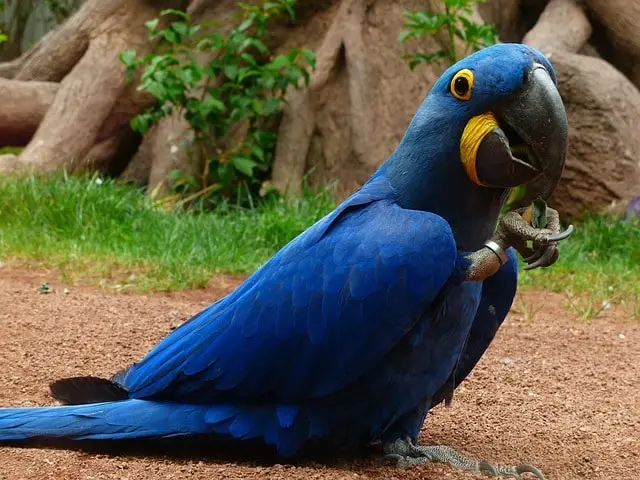
Scarlet Macaw
The stunning tri-colored plumage of the scarlet macaw gives them a dignified appearance in the parrot kingdom. Its plumage exhibits a dominant red hue, extending from the head to the upper back.
At the same time, the primary and secondary wing coverts are colored with blue and yellow. They have a face patch around their cheeks which has red lines going across.
They are one of the most beautiful parrot species and as such they are highly coveted as pets. While there is a lot to love about the scarlet macaw, these large birds are not birds for everyone due to their size, loudness, and temperament.
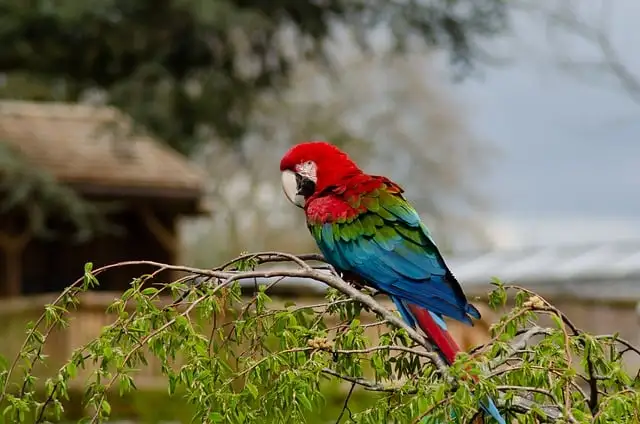
Blue And Yellow Macaw
Aptly named, the blue and yellow macaw features two main colors in its brilliant plumage. Its upper parts, including the wings and back, have a royal blue color, while the lower parts, such as the chest and belly, feature a striking rich yellow hue. The facial region is marked by a white patch, and the bare skin on the face has black lines running across it.
They are sociable creatures with a friendly personality. However, for someone with a lack of experience can be intimidating. These birds have loud calls that can get your ears ringing. They are also incredibly huge with a giant hooked beak.
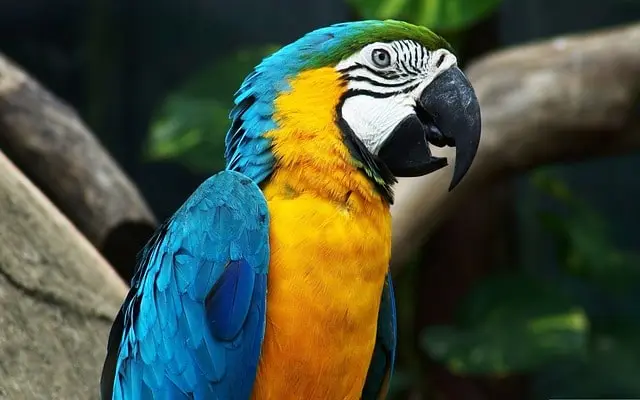
Hawk-Headed Parrot
The hawk-headed parrot, also known as the red-fan parrot is a colorful bird native to the Amazon Rainforest. Its distinctive feature is the red feathers on its nape that can form into a fan behind its head. It happens when the parrot is scared or excited and raises its neck feathers.
Hawk-headed Parrots have soft white foreheads and crowns, with dark brown lores. The feathers on the occiput and sides of the head are brown streaked with white.
The long feathers on the hindneck are dark red-edged with blue. The back and wings are green, while the breast and abdomen are dark red, scalloped with blue. The tail is green with hidden maroon at the base.
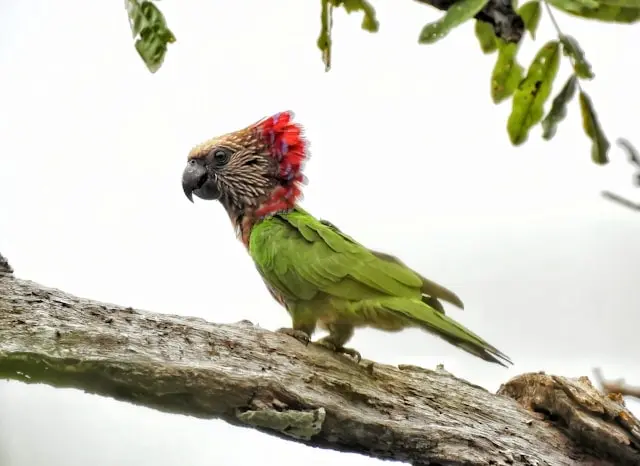
Plum-headed parakeet
Plum-headed parakeets have primarily green feathers with a darker shade on their wings and light green on the abdomen and breast. They are sexually dimorphic parrot species.
The males have purplish-red heads with a black ring around their necks, while females have blueish-purple heads without the black neck stripe.
The iconic plum head distinguishes its head from the rest of the body and gives it an elegant look. They are shy birds and can be a bit flighty at the beginning, so you need to work on building a bond with them. But once they are out of their shy phase, they can be very affectionate pets.
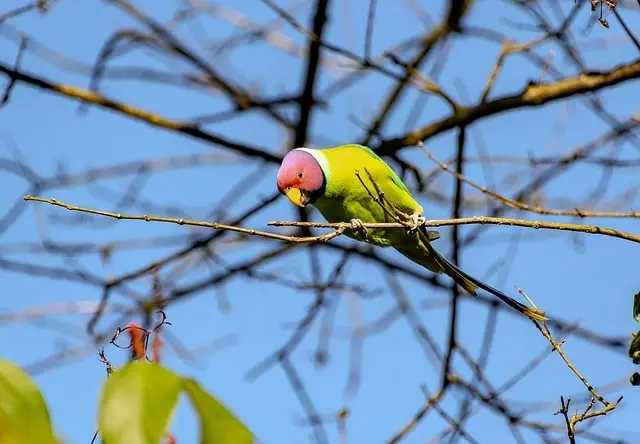
Lilac-Crowned Amazon
The Lilac-Crowned Amazon has a green body like all the other Amazons, and its head is a pretty mix of lilac and maroon colors. The forehead is maroon in color while the crown and nape are blueish lilac.
It is one of the smaller amazon species. This parrot can become a loyal and playful companion. However, it is better suited to be handled by seasoned bird owners.
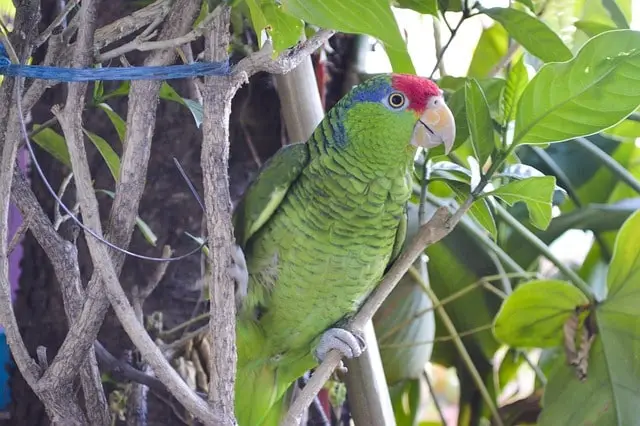
Golden Conure
Distinguished, elegant, and dazzling, the yellow plumage of the golden conure is like the gleaming ray of sunlight.
Golden conures, also known as golden parakeets, are brightly colored with a yellow body and dark green flight feathers.
These birds are primarily found in northern Brazil south of the Amazon River. Their habitat includes dense tropical forests, where they dwell in tall trees.
Golden Conures are active and high-energy birds. They vocalize very frequently and being a conure, they are fairly loud. These birds love to engage in social interactions and form strong connections with their owners.
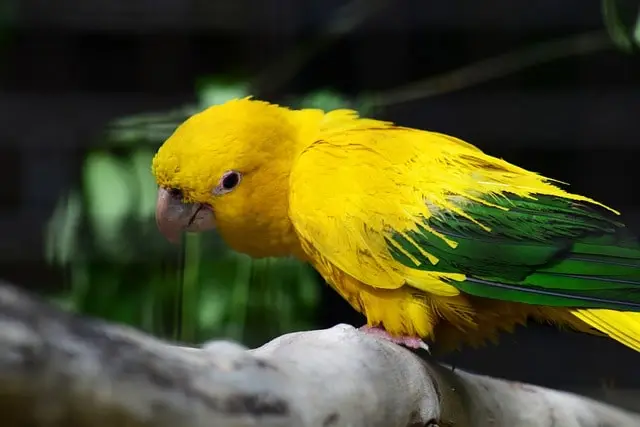
Dracula Parrot
The Dracula parrot is an unusual, yet fascinating bird. Because of its menacing look and the combination of red and black feather colors, it has been given the name, Dracula parrot.
Their breast and upper abdomen are black with scalloped grey feathers, while the belly, thighs, underwings, and outer flight feathers are bright red.
The Dracula Parrot has a bald head, which bears resemblance to a vulture but it’s actually a frugivore bird, especially fond of different types of figs.

Bronze-Winged Parrot
The bronze-winged parrot is a stocky bird belonging to the family of Pionus parrots. It has an interesting look with a very different color palette from other parrots.
The Bronze-Winged Parrot has a dark blue body with a bronze beak, and wing feathers tipped in dark brown. They have a white chin and a wide band of dull pink on the foreneck. The upper back, mantle, and scapulars are bronze, while the rump and lower back are deep blue.
They are easy-going birds that do not need as much time dedicated to socialization. They are generally happy with spending minimal time with you every day, though they should have other forms of enrichment in their cage to keep them entertained.
Crimson Rosella
The crimson rosella is native to eastern and southeastern Australia. These birds have an uncommon set of colors used in their plumage – red, blue, and black.
The crimson rosella are mostly bright red with blue tails and outer primary flight feathers. In addition to that they have detailed black scalloping extending from their nape to their lower back.
They are affectionate as pets, but not particularly cuddly. They are pretty chatty and social and do need a lot of time from their owners.
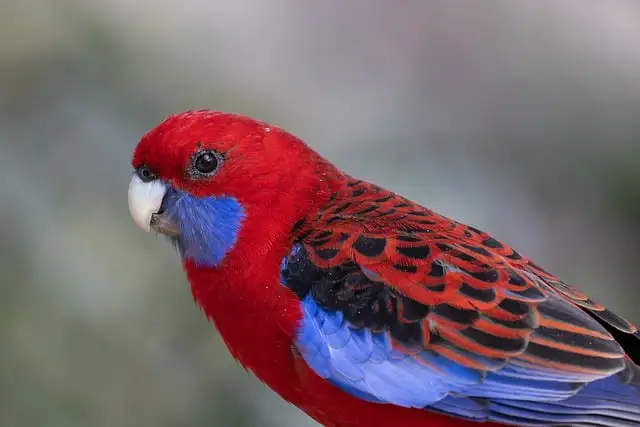
Blue-Streaked Lory
The blue-streaked lory is native to the Tanimbar Islands and Babar in the southern Moluccas. Its plumage coloration is unlike any other parrot.
The blue-streaked lory has a mostly red body with black markings on the wings, back, and tail. Its most charming feature is the iridescent blue streaks that run across the eye to the nape. The blue streaks appear as if bejeweled on their faces and stand out distinctively from a distance.
